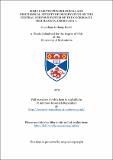Files in this item
Some electrophysiological and biochemical effects of denervation on the central nervous system of the cockroach, Periplaneta Americana L.
Item metadata
| dc.contributor.advisor | Pitman, Robert | |
| dc.contributor.author | David, Jonathan Anthony | |
| dc.coverage.spatial | 219 p. | en_US |
| dc.date.accessioned | 2018-07-03T16:35:40Z | |
| dc.date.available | 2018-07-03T16:35:40Z | |
| dc.date.issued | 1979 | |
| dc.identifier.uri | https://hdl.handle.net/10023/14873 | |
| dc.description.abstract | The effect of denervation on the excitability of cockroach central neurones has been investigated using both extracellular and Intracellular recording techniques. Stimulation of the anterior connectives produced a response in the flexor tibiae muscle 143b of the metathoracic segment. This muscle response could be correlated with action potentials in the anterior connective and fifth nerve trunk innervating the leg. The ganglionic delay for this pathway was 1,42 +/- 0.07 ms (n=6) suggesting the presence of a single synapse. This was reduced to 0.86 +/- 0.10 ms (n=10) 19-96 hours after cutting the contralateral fifth nerve trunk. It is suggested that this reduction in ganglionic delay could result from an increase in the excitability of the postsynatpic cell caused by differentiation. Intracellular recording were made from the cell body of the fast coxal depressor motoneurone (Df) in the me metathoracic ganglion. Acetylcholine (ACh) applied to the soma either topically or by iontophoresis caused dopolarisation of the cell membrane and if repeated in large doses resulted in rapid desensitisation and depression of the response. Some Df motoneurones were axotomised by cutting the ipsilateral fifth nerve trunk 4-118 days before the experiment. The sensitivity to ACh increased approximately three fold following axotomy. However there was no change in the mean resting potential, input resistance or membrane time constant. The change in sensitivity to ACh produced by axotomy was apparently not a result of a redistribution of cholinoceptors on the soma membrane since the rise Lime of the ACh responses were similar in control and axotomised preparations. Analysis also showed that there was no difference between control and axotomised cells in the number of ACh molecules needed to combine with individual cholinoceptors to produce a response. Similarly there was no significant difference in the mean values of the ACh reversal potential in control and axotomised neurones (as determined by extrapolation). It is suggested that the supersensitivity to ACh is due to a decreased inactivation of ACh by acetylcholinesterase since (i) the anticholinesterases physostigmine and neostigmine produced a greater potentiation of the ACh response in normal than in axotomised neurones and (ii) there was no significant difference in the sensitivity of control and axotomised cells to carbamylcholine. This suggestion is supported by the results obtained from a biochemical study in which the cholinesterase activity of normal and denervated metathoracic ganglia was determined. Denervation was produced by transection of both fifth nerve trunks 5-8 days before the assay. Denervated ganglia showed an approximately 33% reduction in their capacity to hydrolyse AThCh. | en_US |
| dc.language.iso | en | en_US |
| dc.publisher | University of St Andrews | |
| dc.subject.lcc | QL508.B6D2 | en |
| dc.subject.lcsh | Cockroaches | en |
| dc.title | Some electrophysiological and biochemical effects of denervation on the central nervous system of the cockroach, Periplaneta Americana L. | en_US |
| dc.type | Thesis | en_US |
| dc.contributor.sponsor | Maitland Ramsay studentship fund | en_US |
| dc.type.qualificationlevel | Doctoral | en_US |
| dc.type.qualificationname | PhD Doctor of Philosophy | en_US |
| dc.publisher.institution | The University of St Andrews | en_US |
This item appears in the following Collection(s)
Items in the St Andrews Research Repository are protected by copyright, with all rights reserved, unless otherwise indicated.

